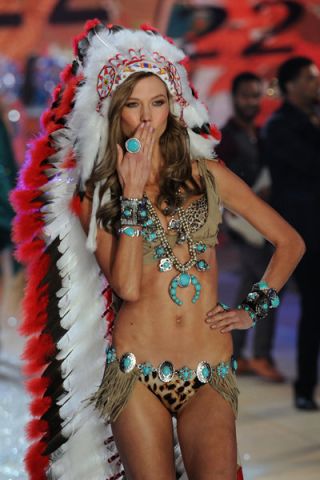Bias
Was Victoria’s Secret Being Racy or Racist?
What the Native American headdress controversy reveals about racial attitudes.
Posted November 14, 2012

The Victoria’s Secret annual fashion show is for many a highly celebrated television event. Scantily-clad waifish models strut around in stilettos with wings, diamonds, and any other embellishment possible to up the wow factor. This is to mean wow us beyond the already impressive (and/or disturbing depending upon the reader) fact that they are parading around with roughly 10% of their bodies covered under impossible conditions (potential eating disorders and sky-high heels included). The women on display are undoubtedly attractive in an almost other-worldly way. In fact, my most read article of all time on Psychology Today was on the notion of “exotic beauty” inspired by one of Victoria Secret’s own models, Adriana Lima. Clearly, the executives and heads at the lingerie powerhouse somehow missed my earlier article. Though Victoria’s Secret is always making headlines around the time of their annual televised fashion show, this time it is a grave racial message that is making news. One of the ensembles featured a Native American headdress paired with leopard print undergarments. This news story here captures many of the valid concerns brought up some of the leaders in this community. For starters, we all know the connotation of leopard and that it is synonmous with "wild" things. Pairing it with anything suggested to be related to native and other indigenous populations sends a pretty clear message. The bottom line is the choice was a highly disrespectful one. Though the particular ensemble will no longer be included in the televised version of the show when it airs in December, it still raises concerns about our nation’s racial report card.

Not too long ago, fliers such as the one shown on the left were being distributed around selecting racially sensitive costumes for Halloween. But racial stereotypes are often implicit. Hence, while we may explicitly deny any racist thoughts or intentions, these attitudes are transformed into what multicultural researchers call racial microaggressions. Essentially, these are the same racist attitudes but internalized and on a more subtle level.

Take for example this photograph of President Barak Obama. While intended as humorous, what does it say about assumptions about Black individuals? The reality is that we are a long way from a post-racial society. But the good news is that communities are slowly standing up for themselves one step at a time in correcting such egregious errors. So Victoria’s Secret, don’t think we won’t hold this one against you for some time. It was one thing when “low-rise” was the primary cut of panties you offered us, but this takes things to a whole new level.
Follow me on Twitter at MillenialMedia


